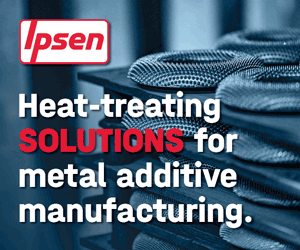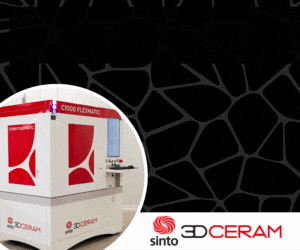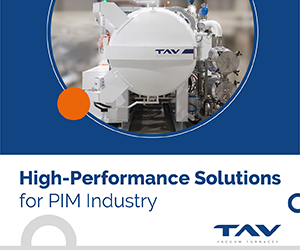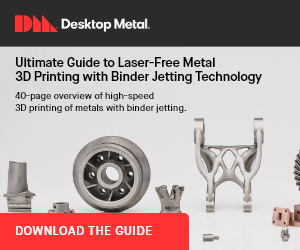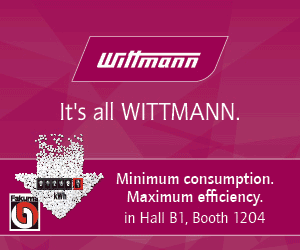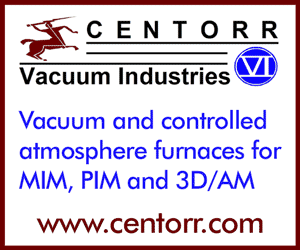PIM diamond-copper composites for electronic packages
August 1, 2012
As published in PIM International Vol 6 No 2 June 2012
Researchers at Weifang University in Weifang, China, have successfully used a combination of powder injection moulding (PIM) and copper pressure infiltration to produce diamond-copper composites with a high volume fraction of diamond powder.
The diamond-copper composites have high thermal conductivity, low coefficient of thermal expansion (CTE) and are intended for the third generation thermal management materials in applications such as electronic packaging. According to a paper presented at the 2011 International Conference on Electrical and Control Engineering (ICECE 2011) held in Yichang, China, September 16-18, the authors Chi Yuan and Jian Wang found that in optimal conditions they could produce high thermal conductivity packaging with a 62% loading of diamond powder. The powder injection moulded diamond preform was infiltrated with copper at 1450°C and at a pressure of 30 MPa with holding time of 25 minutes to give a final density of 99.7%. The thermal conductivity was reported to be 530W/(m-K), and the coefficient of thermal expansion (CTE) ranged from 5.5 ppm/K to 7 ppm/K in the temperature range from 50 to 400°C. These properties are said to meet the demands of electronic packaging materials.
PIM SiCp/Al composite packaging materials
Another group of Chinese researchers at the State Key Laboratory for Advanced Metals and Materials at the University of Science and Technology Beijing, recently reported on the use of powder injection moulding to produce near-net-shape packages using SiC/Al composites. Here PIM was also used to produce the SiC performs with a 63 vol% SiC powder loading. The PIM performs were pre-sintered and then infiltrated with aluminium by pressure/pressureless (~75 MPa) infiltration at 1000-1200°C.
According to a paper published in Progress in Natural Sciences: Materials International (‘Review of metal matrix composites with high thermal conductivity for thermal management applications’ by Xuan-hui QU, Lin ZHANG, Mao WU, and Shu-bin REN, Vol. 21, June 2011, pp 189-197; available online 21 March 2012) the feedstock for the PIM process is produced by mixing SiC powder and the binder in the double planetary mixer in the temperature range of 135-160°C. The preforms are injected moulded at a pressure of 60–80 MPa, and the moulded preforms are subjected to debinding and pre-sintering.
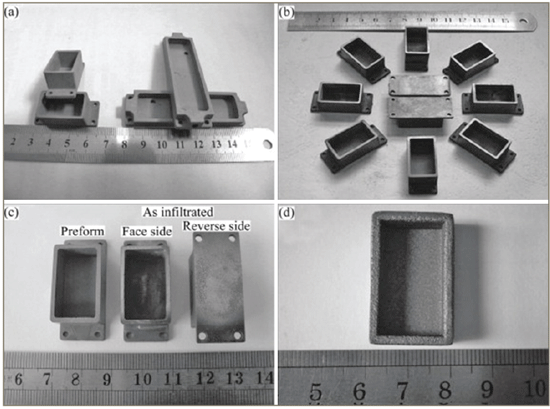
Fig. 1 Various kinds of net-shape metal matrix preform and corresponding composites: (a) SiC perform; (b) Infiltrated SiCp/Al; (c) Infiltrated SiCp/Cu; (d) Infiltrated diamond/Cu
Fig. 1 (a) shows a SiC preform fabricated by PIM. Figs. 1 (b), (c) and (d) indicate SiCp/Al, SiCp/Cu and diamond/Cu composites respectively, fabricated by the combination of powder injection moulding and pressureless infiltration. The relative density of the SiC/Al package was reported to be over 99% with average CTE values lower than 7×10−6 K−1 between 25°C and 100°C, and thermal conductivity of over 190 W/(m•K). This is significantly lower than the vCTE and TC values found for diamond-copper composite packaging materials.
News | PDF Store | Magazine Subscriptions | What is PIM? | e-newsletter







